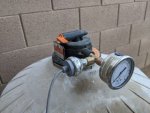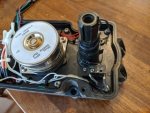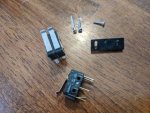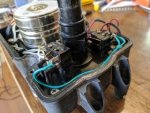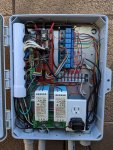@Katodude and
@arib0nd...thanks for the advice on the relays...I made that change and now the valve relays are driven for 20 seconds before shutting off. That gives enough time to rotate the valves to their final position. I don’t turn off the 24vac transformer as Ari does, simply because that transformer is in my electrical box instead of my pool-controller box, but that transformer has been powered 24/7 for about 5 years and would be a cheap replacement.
Unfortunately work on this project has stalled a bit due to full-time care with 3 grandkids (day and night) due to covid hardships. I have cleaned up various sections of code and am expanding my use of the Photon’s 2Kbytes of EEPROM (permanent storage that is not lost at power down).
I previously used 32x8 bytes of this EEPROM for my schedule entries and 16x8 bytes for recent chemical testing entries (pH, FC, cya, TA, CH). I have added one month historical data entries for daily high/low pool temperatures, daily acid injection history, daily chlorine injection history (32 bytes each). All that “historical data” is also permanently stored in the google spreadsheet but it is convenient to have a local copy on the Photon as well. The other main items I will store in this this semi-permanent EEPROM are various parameters that can be modified/compared for pool operation: default values, standard operating parameters such as psi and watts for run-time comparisons to ‘known’ good and/or normal values. These will be used to detect and report “problems” in the system. These values will also be updateable/changeable via the phone app.
But I have an issue with my Ecostar pump. The watts value it is reporting occasionally gets stuck at a previous value and doesn’t change unless I do a power cycle for the pump itself. Prior to a couple months ago, this “stuck watts value” had only happened twice in the previous 5 years. That is one of the reasons that I wanted to dedicate a relay to turn off the power to the Ecostar...if I was traveling, I wanted the ability to reset the pump for this rare occasion. Unfortunately this problem has accelerated in the last couple months and it happens regularly now...every few days. There doesn’t seem to be any other ramifications of this problem except for wrong watts being reported, both over the RS485 bus AND on the pump display.
So, when I have some time, starting next weekend, I will be looking at implementing the AC current monitor for the pool pump to do independent power calculations for the Ecostar. I like having an accurate watts number for a number of reasons which I haven’t talked about much to this point...but i will be using it eventually to fully characterize my systems performance including energy efficiency. I have some ideas for further optimizations of operation of my in-Floor-Cleaning-System (IFCS). I have already spent waaaay too much time on those optimizations, but as I have said before, this has become an enjoyable and educational hobby.
My wife and I have no current plans for further long trips so the urgency for remote monitoring has diminished a bit. I can implement those plans at a slower rate. At this point I think my project implements the minimum requirements I NEED, everything else is gravy, and fun stuff, haha...still so much I can envision including cleanup/expansion of the user interface (Android phone app).


